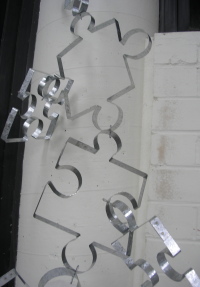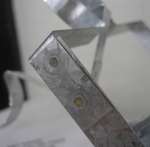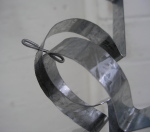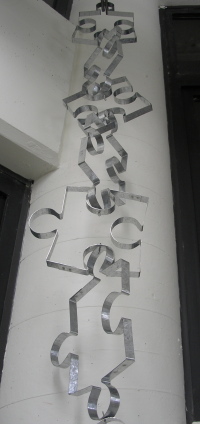
"Selves" (2009) - steel sheet and steel wire
Background
I almost titled this section "Space: The Final Frontier." You see, I did this work as a part of a sculpture class. In the first half of the class, the focus was on mass; I worked in clay and plaster. The second half of the class emphasized space. Space:
- a continuous area or expanse that is free, available, or unoccupied
- an empty area left between one-, two-, or three-dimensional points or objects
- the dimensions of height, depth, and width within which all things exist and move
I was supposed to develop a work that explored three-dimensional, volumetric form, and that consisted of repetitive elements involving change or variation. There was a selection of sheet metal and metal wire available for the project; ideal, perhaps, for the more abstract forms that often result from an exploration of the space around and between objects.

Concept
I had a plethora of ideas revolving around selves, self-reflection, consciousness, perfection, how people interact and connect, the Fibonacci sequence and the golden ratio, mirrors, infinity, the way pieces of ourselves are shared, facets of ourselves, the way people are perceived, and... well, the list goes on.
The idea I finally narrowed down on is best explained by the following metaphor: A person is a set of puzzle pieces. The puzzle pieces add up to create the pattern of who one is, shaped both from within, and from others' outside perceptions. Some pieces are unique to oneself. Some pieces are identical to those that compose other people. Some pieces almost match up, but not quite. People overlap and interconnect.
At first glance, relationships appear straightforward--as in the chain of puzzle pieces: at the top, it is more orderly, periodic, and coherent. I overlap with this person because of a shared interest in robots. She and I went to the same high school. He and I both react calmly in upsetting situations. But the more you know a person, the more levels down you dig, the farther down the chain you go, the more chaotic it becomes. Pieces branch off the main line. There are more overlaps, more connections, more intricacies. The pieces don't fit together cleanly.
Many of my initial sketches focused too much on mass and not enough on space. As I did more research, I noticed that the works I found most appealing were those that involved space and interacted with it, instead of just presenting forms bounded by their own edges--exactly what this project was all about. I also realized I did not have to make my ideas so explicit--I could suggest instead of state, and with that change, remove a layer of visual noise. The final design is far more simple than my initial sketches.
Even after I built the puzzle piece frames you see in the chain, it took me quite some time to decide how best to arrange them. Early thoughts involved placing some frames inside others to create 3D pieces, but I experimented with all possible arrangements: laying all twelve frames flat in a grid, stacking them, suspending them from a mobile, lining them up... Then I tried hanging them in the chain you see in the photos. It's always the last thing you try that works!
Materials & Construction

The puzzle piece frames are constructed from galvanized steel sheet metal (zinc-coated). I cut the sheet metal into strips 1.5cm wide and bent the strips into shape with a simple pair of pliers. Each strip was long enough to make about half of a puzzle piece frame, so I spot-welded two strips together for each frame, taking care not to breathe in the toxic fumes from the zinc.

To connect the pieces in the chain, I drilled a hole through the steel at each connection point, then slipped a bit of galvanized steel wire (1.6mm gauge) through the holes and folded the ends over. Simple, easy, and able to be disassembled if necessary.





